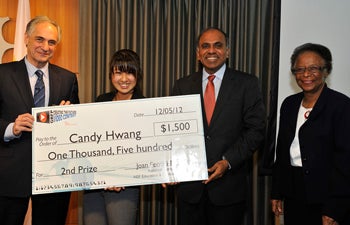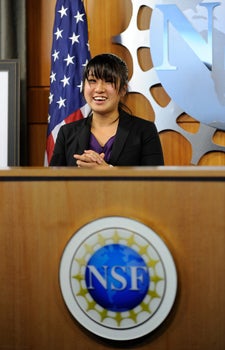The Little Enzyme That Could
The cute kiddie cartoon shows an animated Candy Hwang wearing a white lab coat jotting down data on her clipboard.
But the 90-second video is not child’s play. Called The Secrets of Nitrogenase, it clearly and concisely conveys the complex science behind the bacteria that have the nitrogenase enzyme. This enzyme combines gaseous nitrogen with hydrogen to produce ammonia — the second most commonly produced chemical in the world after sulphuric acid.
“We use it in cleaning. We use it in fertilizers. We use ammonia in so many products,” said Hwang, a second-year chemistry doctoral student in USC Dornsife. “But the way that the industry makes it requires very high temperatures and pressures. The production of ammonia right now uses an extensive amount of fossil fuels that are emitted into the air.”
The nitrogenase enzyme achieves the same chemistry to make ammonia, she said.
“But it doesn’t require high temperatures and pressures.” Hwang said. “It actually does it at ambient pressure. It needs no fossil fuels. So if we can figure out how this enzyme does this chemistry, we could improve our own catalysts for these industrial processes — and therefore reduce the amount of fossil fuel emissions.”
The short video delivered a powerful punch at the National Science Foundation’s (NSF) video contest that challenged graduate research fellows to create a 90-second video showing how their research could help shape the future. Chosen as a fellow in NSF’s Graduate Research Fellowship Program (GRFP) in March 2012, Hwang won second place in a pool of 63 entries. A panel of NSF and media members looked for videos with the greatest visual impact, originality and most effective communication.
She also won the people’s choice award after receiving the majority of the 1,975 votes cast. Hwang was honored during the NSF Graduate Research Fellowship Program’s 60th anniversary ceremony, held in Washington, D.C., on Dec 5.
The USC Dornsife student also spoke during the event. GRFP students belong to an elite group. Currently, about 12,000 students apply annually for the fellowships and 2,000 are awarded. Winners can use the NSF funding in any United States graduate institution of their choice.
Hwang was elated to have won the awards.

USC Dornsife’s Candy Hwang accepts her cash prize for her 2nd place win in the NSF’s Graduate Research Fellowship Program video contest on Dec. 5 in Washington, D.C. Hwang also received the people’s choice prize, with an additional prize of $1,000. Pictured with Hwang are (left to right) Robert Zimmer, National Science Board member; Subra Suresh, director of NSF; and Cora Marrett, deputy director of NSF. Photo by Sandy Shaeffer for the National Science Foundation.
“It was a motivational tool,” she said. “Because when I won I said, ‘OK, a group of scientists believe in what I’m doing and they believe in me.’ It just motivated me to want to work harder.”
She said becoming a fellow was the most gratifying experience in her life.
“I remember getting the e-mail at 4 a.m. that I had won the fellowship,” she recounted of getting up after hearing her iPhone ping. “I couldn’t get back to sleep. I was bursting with excitement.”
The aspiring professor and Atlanta, Ga., native said creating the video helped to hone her science teaching skills. In making the video, she partnered with animator graduate students at the USC School of Cinematic Arts. A student at the USC Thornton School of Music composed the music.
“I spent several months researching and writing notes to the animators,” Hwang said. “I had to teach them about chemistry. We couldn’t start right away with the animation. They asked questions. I taught them. It was very much a process.”
The hardest part was cutting it down to 90 seconds, she said.
“It’s such a rich topic and so interesting, but we had to keep cutting out things to get to the core central message,” she said. “It was challenging because scientists write in such a technical manner. We don’t want any ambiguities; we want to make sure that we are correct, rigorous and clear. The animators and I would argue over certain points. They would say we need to use this word because it sounds better. And I would tell them we can’t use that word because it implies something incorrect. We’d go over it and over it and over it again.”

Hwang makes remarks before an audience of NSF leadership, National Science Board members, former NSF fellows and others after accepting her 2nd place prize in the NSF Graduate Research Fellowship Program video contest on Dec. 5. Photo by Sandy Shaeffer for the National Science Foundation.
Hwang, who works in the laboratory of Charles McKenna, professor of chemistry and vice dean for natural sciences in USC Dornsife, created the video with McKenna’s encouragement. He immediately embraced the idea of Hwang entering the contest.
“This is an example of bridging science and creative arts,” McKenna said, adding that Daphne Sigismondi, assistant director and student adviser for the John C. Hench of Animation & Digital Arts at USC and her students, provided critical technical support while Hwang furnished the concepts and science.
“They learned from one another in an exciting interdisciplinary project.”
McKenna said it was good practice for Hwang to attempt to communicate science to the general public in a compelling and visually accessible way. Helping to create the graphics in the video, he said, was also good preparation for Hwang, who as a scientist will have to submit such graphics capturing the essence of her research as supporting material with her manuscripts for publication in scientific journals.
Hwang said she chose USC Dornsife because she was drawn to McKenna’s research on an enzyme that is essential for life on Earth.
“This is something that can benefit society,” she said. “When I’m in the lab, even when I have little discoveries it’s, ‘Yes! I’ve contributed something. I’ve discovered something on my own.’ ”